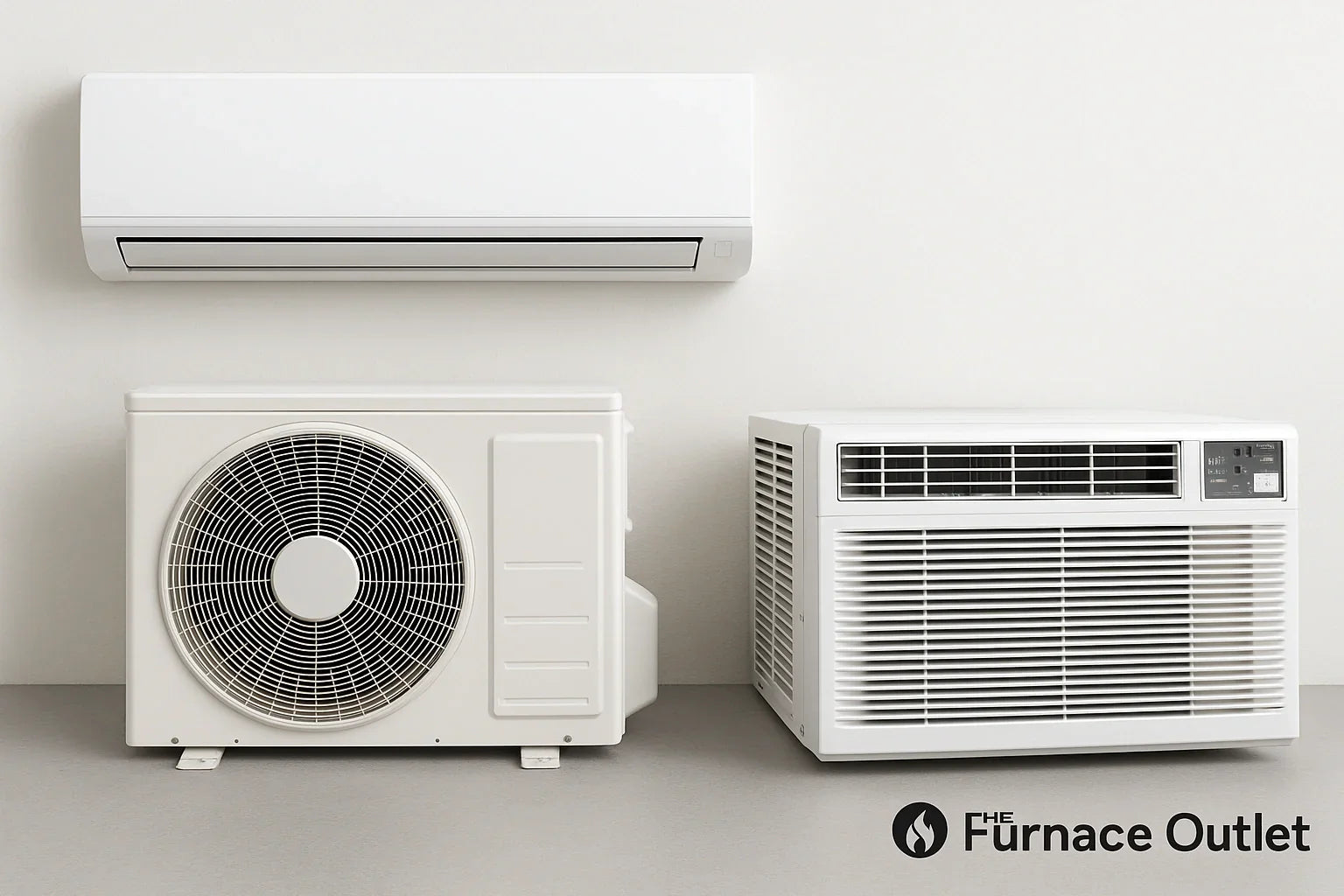Key Takeaways
-
Mini-splits are super efficient—usually SEER 20+ vs. window AC’s SEER 12.
-
They use ~40% less power for the same cooling.
-
Higher cost, but lower bills—payback in 3–7 years for hot climates.
-
They also heat, run quietly, and let you control each room.
-
Window units are cheaper—great for renters or spare rooms.
-
Use a mini-split if you cool daily; use a window AC for occasional use.
Why This Choice Matters
Summer bills keep rising, and U.S. law now demands better efficiency. Many homes weigh quick, cheap window ACs against higher-end mini-splits. The problem: price and performance pull in opposite directions. This guide breaks down the trade-offs so you can spend once and chill forever. Recent inverter tech and stricter SEER2 rules make today’s decision different from even five years ago. By the end, you’ll know which unit saves money and fits your life.
Today’s ductless systems routinely hit SEER 20+, making them ideal for high-usage homes. Explore energy-saving mini-split systems that cool smarter and last longer.
How Mini-Splits Achieve Top-Tier Efficiency
Mini-splits use inverter-driven compressors that speed up or slow down instead of turning fully on/off. That steady run avoids energy-hungry restarts and keeps temps rock-solid. With no ducts, they dodge the 20–30 % air loss found in many attic runs. Zoned heads cool only the rooms you’re actually in, cutting waste even more. Real-world lab tests show many models topping SEER 20 and some surpassing 30 SEER If you want to dive deeper into sizing and placement, read our Mini-Split Basics Guide.
Why Window Units Lag Behind
Most window units rely on fixed-speed compressors that cycle on at full blast and then shut off. That seesaw wastes power and wears parts. ENERGY STAR models trim usage about 10 %, but average ratings still hover around SEER 12. A few 2025 “smart” in-window inverters stretch to CEER 15, yet they cool just one room.
Need a quick, affordable cooling solution? Browse our 2025 window AC models featuring ENERGY STAR efficiency, smart controls, and simple DIY installation.
Up-Front Costs in Plain Numbers
A window AC good for a 300 ft² bedroom can cost $250–$600 and is DIY-friendly. By contrast, a single-zone mini-split covering the same space runs $1,500–$2,000 for equipment plus $500–$1,500 for a licensed install. Multi-zone systems rise from there. Federal tax credits (30 %, max $2,000) plus utility rebates shrink that gap, but the sticker shock is real. If you’re only renting for a year or two, spending less may be smarter.
For heating and cooling in one, choose a heat-pump mini-split that runs quietly year-round—even in freezing weather.
Operating Costs & Payback
Because a mini-split draws far fewer kilowatt-hours, the average U.S. homeowner using cooling eight months a year can save 25–40 % on summer bills. Multiply that by today’s national average $0.16 /kWh, and the extra equipment cost often returns within one HVAC life cycle. Window units, meanwhile, may last 8–12 years and often get tossed when they grow noisy or rusty. That replacement loop quietly chips away at their low entry fee. See more real-world math in our Energy-Savings Tips roundup.
Comfort: Noise, Airflow & Even Temperatures
Mini-splits hum at library-level volumes and spread air across a room with gentle, variable-speed fans. Window units sit in the sash, so you hear the compressor directly and lose daylight. Modern U-shaped designs help, but they still pull outside noise inside. In heating season, a heat-pump mini-split flips and keeps the same quiet operation, while a window AC sits dormant, forcing you to add space heaters.
Want ultra-quiet airflow with zoned control? Try our DIY mini-split kits that deliver pro-level comfort without breaking the bank.
Year-Round Flexibility & Heating Ability
Every mini-split sold through The Furnace Outlet doubles as a heat pump, many still cranking at 0 °F. That lets one unit handle two jobs with high efficiency. Standard window ACs provide cooling only. A few through-the-wall hybrids add resistive heat strips, but they burn more watts than they save.
Home Value, Aesthetics & Space
Because mini-splits mount high on a wall and clear the window, they preserve natural light and curb appeal. Appraisers often count them as a permanent upgrade, nudging resale value up. Window units block views, drip condensate, and must be removed for winter in colder states. They rarely factor into a sale price.
If you want to know why many households still choose them anyway, skim our Window AC Popularity Explainer.
Quick Decision Checklist for U.S. Homeowners
-
Cooling more than 4 months a year? → Favor a mini-split.
-
Own the home and plan to stay ≥ 5 years? → Mini-split payback likely.
-
Renting or need a quick fix for one room? → Window AC wins.
-
Need winter heat or ultra-quiet bedrooms? → Mini-split.
-
On a shoestring budget or strict HOA rules? → Window AC or wait for rebates.
Still undecided? For the best of both worlds, check out wall AC units that dehumidify efficiently while staying renter-friendly and code-compliant.
Frequently Asked Questions
Q1. Can I install a mini-split myself?
DIY kits exist, but local codes often require a licensed electrician for the 240 V line and pressure test.
Q2. How long do mini-splits last?
With routine filter cleaning and annual tune-ups, 15–20 years, about double many window units.
Q3. Do mini-splits still work when it’s freezing?
High-quality systems heat efficiently down to about 0 °F; cold-climate models push even lower.
Q4. What size unit do I need?
A quick rule: 20 BTU per square foot for well-insulated rooms. Use our free sizing calculator in the HVAC Tips blog for accuracy.
Q5. Are window ACs bad for the environment?
New ENERGY STAR inverters use low-GWP refrigerants and meet 2025 CEER rules, but they still consume more kWh than a mini-split with similar capacity.







